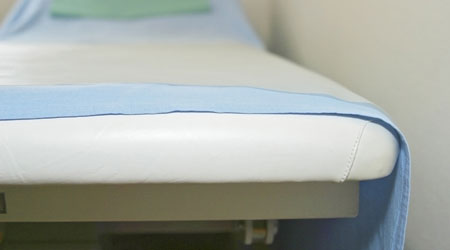
A first-of-its-kind study now “in press” in the American Journal of Infection Control shows a direct correlation between using data from the DebMed Electronic Hand Hygiene Compliance System to improve the World Health Organization’s (WHO) Five Moment compliance and significantly reduced hospital onset Methicillin-resistant Staphylococcus aureus (MRSA) infections. MRSA is a form of bacterial infection that is most often transferred on hands, resistant to antibiotics, and difficult and expensive to treat.
The study, “Electronic Hand Hygiene Monitoring as a Tool for Reducing Healthcare-Associated Methicillin-resistant Staphylococcus aureus Infection,” was conducted at Greenville Health System (GHS) in Greenville, S.C. Researchers utilized hand hygiene compliance data from the DebMed System to measure the impact of hand hygiene compliance rates on the incidence of healthcare-associated infections (HAIs), such as MRSA. In addition, the study showed that costs associated with providing care to infected patients over an extended length of stay were avoided.
Key findings:
• Hand hygiene compliance rates increased by 25.5 percent*
• Hospital onset MRSA HAI rates decreased by 42 percent*
• Total costs of care avoided were approximately $434,000
*Statistically significant
“This breakthrough research proves that real-time electronic monitoring of hand hygiene compliance based on the WHO Five Moments can lead to clinically important organizational change and improved patient safety,” said J. William Kelly, MD, Infectious Disease Specialist at GHS and principal investigator of the study. “Integrating a validated technology capable of tracking WHO Five Moments behavior in our processes provided us with actionable feedback to drive staff behavior change that resulted in increased hand hygiene compliance and decreased infection rates.”
The DebMed System is based on the WHO Five Moments for Hand Hygiene guidelines, which represent a higher clinical standard facilities across the U.S. are beginning to implement to enhance patient safety and infection control. Because of this, the number of hand hygiene opportunities reported by the DebMed System is greater and more accurate than the number reported by systems that only monitor hand hygiene before and after contact with a patient, or room entry and exit. The DebMed Electronic Hand Hygiene Compliance System is installed throughout all seven of GHS’s hospitals.
Connie Steed, MSN, RN, CIC, Director of Infection Prevention at GHS and a MRSA study co-author, has been working with DebMed for the past seven years. Their collaboration demonstrated that electronic monitoring technology based on the WHO Five Moments can accurately and reliably measure hand hygiene compliance and now with this new study, that the DebMed System enables feedback that can drive behavior change leading to reduced MRSA infections and associated costs.
“Over a seven-year research collaboration, we achieved significant milestones and now have credible outcomes to show that MRSA HAIs can be reduced when staff are trained on WHO Five Moments and given accurate and reliable feedback based on data from electronic monitoring,” said Steed. “We moved away from Direct Observation (DO), which captures only a small fraction of hand hygiene behavior and omits events that occur in the patient room. Studies show that healthcare workers behave differently when being observed, with one recent national study showing a three-fold increase in hand-hygiene compliance when healthcare workers were observed as compared to when unobserved,” Steed added. “Our study clearly demonstrates that technology like DebMed’s can lead to significant improvement in hand hygiene rates, a reduction of infections and improved patient outcomes.”
The MRSA study was conducted between July 2012 and March 2015 in 23 inpatient units. Data on hand hygiene compliance rates (representing over 20 million hand hygiene events) from the DebMed electronic monitoring reports were provided to unit leadership and frontline staff at Greenville Memorial Hospital, GHS’s flagship tertiary hospital. From April 2014 through March 2015, hospital staff were fully engaged with the use of the data and unit leaders were held accountable for increasing hand hygiene compliance. The study was supported by Deb Worldwide Healthcare, Inc., which had no influence on the design, conduct, analysis, or results of the study.
HAIs are a significant issue in the U.S., with 700,000 infections resulting in 75,000 deaths annually. Most healthcare workers in the U.S. adhere to a standard of cleaning their hands only before and after patient contact, which has been found to miss as much as 50 percent of all hand hygiene opportunities, potentially putting patients at risk of contracting an infection. Alternatively, the WHO Five Moments for Hand Hygiene identifies other moments indicated for hand hygiene in addition to before and after patient contact including: before an aseptic task, after exposure to body fluids and after touching the patient’s surroundings. Missing these three “in the room” moments can produce a high risk of patient contamination and, unless the moments are measured accurately and reliably with timely feedback to staff, the risk of an HAI is elevated beyond a necessary level.
For more information on the study, click here.

 Celebrating BSCAI's 60th Anniversary eBook
Celebrating BSCAI's 60th Anniversary eBook The Down and Dirty on Cleaning in Virus Season
The Down and Dirty on Cleaning in Virus Season How Surfactant Use is Expanding in Commercial Cleaning
How Surfactant Use is Expanding in Commercial Cleaning